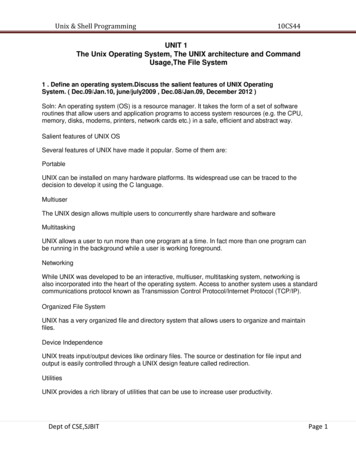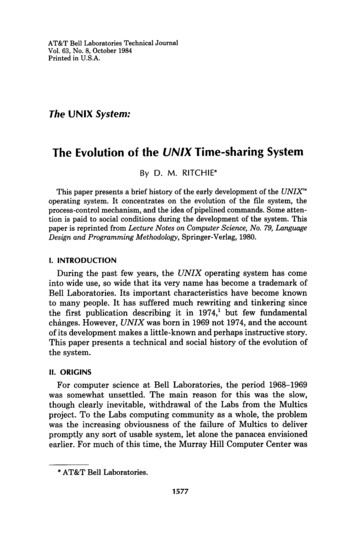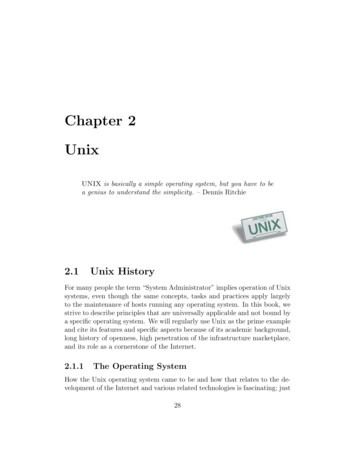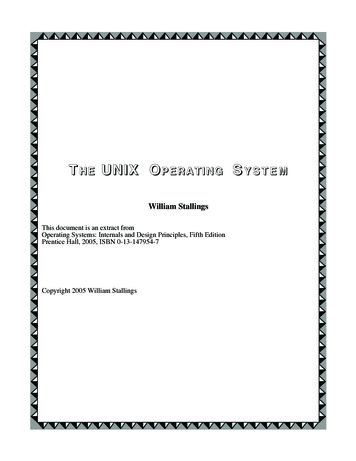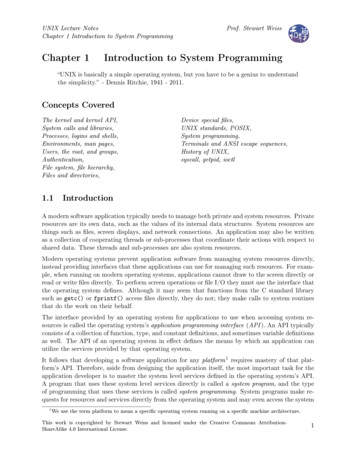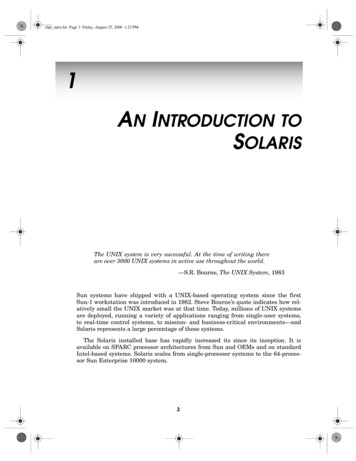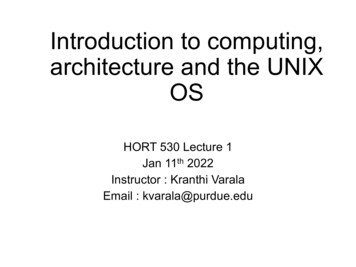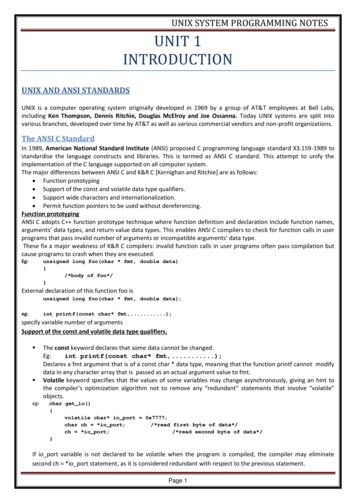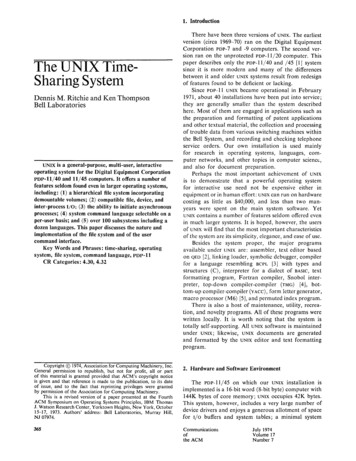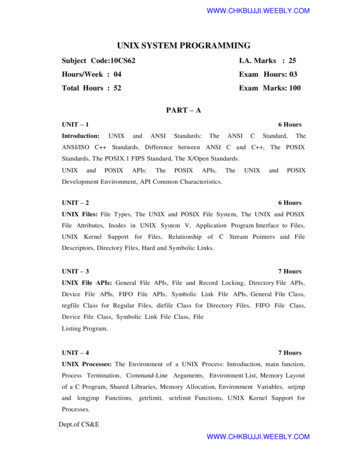
Transcription
WWW.CHKBUJJI.WEEBLY.COMUNIX SYSTEM PROGRAMMINGSubject Code:10CS62I.A. Marks : 25Hours/Week : 04Exam Hours: 03Total Hours : 52Exam Marks: 100PART – AUNIT – 16 ndard,TheANSI/ISO C Standards, Difference between ANSI C and C , The POSIXStandards, The POSIX.1 FIPS Standard, The X/Open POSIXDevelopment Environment, API Common Characteristics.UNIT – 26 HoursUNIX Files: File Types, The UNIX and POSIX File System, The UNIX and POSIXFile Attributes, Inodes in UNIX System V, Application Program Interface to Files,UNIX Kernel Support for Files, Relationship of C Stream Pointers and FileDescriptors, Directory Files, Hard and Symbolic Links.UNIT – 37 HoursUNIX File APIs: General File APIs, File and Record Locking, Directory File APIs,Device File APIs, FIFO File APIs, Symbolic Link File APIs, General File Class,regfile Class for Regular Files, dirfile Class for Directory Files, FIFO File Class,Device File Class, Symbolic Link File Class, FileListing Program.UNIT – 47 HoursUNIX Processes: The Environment of a UNIX Process: Introduction, main function,Process Termination, Command-Line Arguments, Environment List, Memory Layoutof a C Program, Shared Libraries, Memory Allocation, Environment Variables, setjmpand longjmp Functions, getrlimit, setrlimit Functions, UNIX Kernel Support forProcesses.Dept.of CS&EWWW.CHKBUJJI.WEEBLY.COM
WWW.CHKBUJJI.WEEBLY.COMPART - BUNIT – 57 HoursProcess Control : Introduction, Process Identifiers, fork, vfork, exit, wait, waitpid,wait3, wait4 Functions, Race Conditions, exec Functions, Changing User IDs s Accounting, UserIdentification, Process Times, I/O Redirection.ProcessRelationships:Groups, , ProcessControlling Terminal, tcgetpgrp and tcsetpgrp Functions, JobControl, Shell Execution of Programs, Orphaned Process Groups.UNIT – 67 HoursSignals and Daemon Processes: Signals: The UNIX Kernel Support for Signals,signal, Signal Mask, sigaction, The SIGCHLD Signal and the waitpid Function,The sigsetjmp and siglongjmp Functions, Kill, Alarm, Interval Timers, Characteristics,CodingRules, ErrorLogging, Client-Server Model.UNIT – 76 HoursInterprocess Communication – 1: Overview of IPC Methods, Pipes, popen, pcloseFunctions, Coprocesses, FIFOs, System V IPC, Message Queues, Semaphores.UNIT – 8Interprocess6 HoursCommunication –2: SharedMemory,Client-Server Properties,Stream Pipes, Passing File Descriptors, An Open Server-Version 1, Client-ServerConnection Functions.Dept.of CS&EWWW.CHKBUJJI.WEEBLY.COM
WWW.CHKBUJJI.WEEBLY.COMText Books:1.Terrence Chan: UNIX System Programming Using C , Prentice Hall India,1999. (Chapters 1, 5, 6, 7, 8, 9, 10)2. W. Richard Stevens: Advanced Programming in the UNIXEnvironment, 2nd Edition, Pearson Education, 2005. (Chapters 7, 8, 9, 13, 14, 15)Reference Books:1. Marc J. Rochkind: Advanced UNIX Programming, 2nd Edition, PearsonEducation, 2005.2. Maurice J Bach: The Design of the UNIX Operating System, PearsonEducation, 1987.3. Uresh Vahalia: UNIX Internals: The New Frontiers, Pearson Education, 2001.Dept.of CS&EWWW.CHKBUJJI.WEEBLY.COM
WWW.CHKBUJJI.WEEBLY.COMTable of contentsSl noChapter DescriptionPage no1UNIT 1 – Introduction . . .1- 62UNIT 2 – Unix Files . . 7-93UNIT 3 – Unix File API’s .10-364UNIT 4 – Unix Processes. 37-415UNIT 5 – Process Control .42-736UNIT 6 – Signals & Daemon Process . . 74-1077UNIT 7 – Interprocess Communication 108-1398UNIT 8 – Network IPC: Sockets . .140-147Dept.of CS&EWWW.CHKBUJJI.WEEBLY.COM
WWW.CHKBUJJI.WEEBLY.COMUNIX SYSTEM PROGRAMMINGINTRODUCTION1.1UNIX AND ANSI StandardsThe ISO (International Standards Organization) defines “standards are documentedagreements containing technical specifications or other precise criteria to be usedconsistently as rules, guidelines or definitions of characteristics to ensure that materials,products, processes and services are fit for their purpose”.Most official computer standards are set by one of the following organizations: ANSI(American National Standards Institute) ITU(International Telecommunication Union) IEEE(Institute of Electrical and Electronic Engineers) ISO(International Standards Organization) VESA(Video Electronics Standards1.2The ANSI C StandardThis standard was proposed by American ANSI in the year 1989 for C programmingLanguage standard called X3.159-1989 to standardize the C programming languageconstructs and libraries.1.3 Major differences between ANSI C and K & R C ANSI C supports Function Prototyping ANSI C support of the const & volatile data type qualifier ANSI C support wide characters and internationalization, Defines setlocale function ANSI C permits function pointers to be used without dereferencing ANSI C defines a set of preprocessor symbols ANSI C defines a set of standard library functions and associated headers.1.4 The ANSI / ISO C StandardThe C language is one of the OOP languages. It was developed by Bjarne Stroustrup at At&T Bell Laboratories. C is an extension of C with a major addition of the class constructfeatures of Simula 67. The three most important facilities that C adds on to C are classes,function overloading, & operator overloading.Dept.of CS&EWWW.CHKBUJJI.WEEBLY.COM
WWW.CHKBUJJI.WEEBLY.COMIn 1989, Bjarne Stroustrup published “The Annotated C Reference Manual” , this manualbecome the base for the draft ANSI C standard. WG21 committee of the ISO joined theANSI X3J16 committee to develop a unify ANSI/ISO C standard. A draft version ofANSI/ISO standard was published in 1994.1.5 Major Differences between ANSI and C Function Declaration or Function Prototype Functions that take a variable number of arguments Type safe linkage , Linkage Directives1.6 POSIX StandardsPOSIX is acronym for Portable Operating System Interface. There are three subgroups inPOSIX. They are :POSIX.1 : Committee proposes a standard for base operating system APIs. This standard is formally known as the IEEE standard 1003.1-1990. This standard specifies the APIs for the file manipulation andprocesses(forProcess Creation and Control).POSIX.1b: Committee proposes a standard for real time operating system APIs This standard is formally known as the IEEE standard 1003.4-1993 unication(Semaphores,Message Passing Shared Memory).POSIX.1c: Committee proposes a standard for multithreaded programming This standard specifies the APIs for Thread Creation, Control, and Cleanup, ThreadinterfaceScheduling,Thread Synchronization and for Signal Handling .To ensure a user program conforms to the POSIX.1 standard, the user should define themanifested constant POSIX SOURCE at the beginning of each program(before theinclusion of any header files) as:#define POSIX SOURCEDept.of CS&Eor2WWW.CHKBUJJI.WEEBLY.COM
WWW.CHKBUJJI.WEEBLY.COMspecify the –D POSIX SOURCE option to a C compiler duringcompilation. g –D POSIX SOURCE filename.cppIn general a user program that must be strictly POSIX.1and POSIX.1b compliant may bewritten as follows:#define POSIX SOURCE#define POSIX C SOURCE 199309L#include iostream.h #include unistd.h int main( ){.}POSIX Feature Test MacrosFeature Test MacroPOSIX JOB CONTROLPOSIX SAVED IDSPOSIX CHOWN RESTRICTEDPOSIX NO TRUNCPOSIX VDISABLEEffects if defined on a SystemIt allow us to start multiple jobs(groups of processes)from a single terminal and control which jobs canaccess the terminal and which jobs are to run in thebackground.Hence It supports BSD version Job Control Feature.Each process running on the system keeps the savedset-UID and set-GID, so that it can change effectiveuser ID and group ID to those values via setuid andsetgid APIs respectively.If the defined value is -1, users may change ownershipof files owned by them. Otherwise only users withspecial previlege may change ownership of any files ona system.If the defined value is -1, any long path name passed toan API is silently truncated to NAME MAX bytes,otherwise error is generated.If the defined value is -1, there is no disabling characterfor special characters for all terminal device files,otherwise the value is the disabling character value.Dept.of CS&EWWW.CHKBUJJI.WEEBLY.COM
WWW.CHKBUJJI.WEEBLY.COMLimits Checking at Compile Time and at Run Time The POSIX.1 and POSIX.1b standards specify a number of parameters that describecapacity limitations of the system. Limits are defined in limits.h . These are prefixed with the name POSIXsysconf, pathcomf and fpathconfTo find out the actual implemented configuration limits System wide using sysconf during run time On individual objects during run time using, pathconf and fpathconf.#include unistd.h long sysconf (int parameter);long fpathconf(int fildes, int flimit name));long pathconf(const char *path, int flimit name); For pathconf(), the path argument points to the pathname of a file or directory. For fpathconf (), the fildes argument is an open file descriptor.1.7The POSIX.1 FIPS StandardFIPS stands for Federal Information Processing Standard. This standard was developed byNational Institute of Standards and Technology. The latest version of this standard, FIPS 1511, is based on the POSIX.1- 1998 standard. The FIPS standard is a restriction of thePOSIX.1-1998 standard, Thus a FIPS 151-1 conforming system is also POSIX.1-1998conforming, but not vice versa.FIPS 151-1 conforming system requires following features to be implemented in all FIPSconforming systems.POSIX JOB CONTROLPOSIX SAVED IDSPOSIX CHOWN RESTRICTEDPOSIX NO TRUNCDept.of CS&EPOSIX JOB CONTROL must be defined.POSIX SAVED IDS must be defined.POSIX CHOWN RESTRICTED must be definedand its value is not -1, it means users with specialprevilege may change ownership of any files on asystem.If the defined value is -1, any long path name passed toan API is silently truncated to NAME MAX bytes,otherwise error is generated.4WWW.CHKBUJJI.WEEBLY.COM
WWW.CHKBUJJI.WEEBLY.COMPOSIX VDISABLE must be defined and its value isnot -1.Must be defined and its value is not -1, Long path namePOSIX NO TRUNCis not support.NGROUP MAXSymbol’s value must be at least 8.The read and write API should return the number of bytes that have been transferred after theAPIs have beenThe group ID of a newly created file must inherit the group ID of its containing directory.POSIX VDISABLEContext SwitchingA user mode is the normal execution context of any user process, and it allows the process toaccess its specific data only.A kernel mode is the protective execution environment that allows a user process to accesskernels data in a restricted manner.When the APIs execution completes, the user process is switched back to the user mode. Thiscontext switching for each API call ensures that process access kernels data in a controlledmanner and minimizes any chance of a runway user application may damage an entiresystem. So in general calling an APIs is more time consuming than calling a user functiondue to the context switching. Thus for those time critical applications, user should call theirsystem APIs only if it is necessary.An APIs common CharacteristicsMost system calls return a special value to indicate that they have failed. The special value istypically -1, a null pointer, or a constant such as EOF that is defined for that purpose.To find out what kind of error it was, you need to look at the error code stored in the variableerrno. This variable is declared in the header file errno.h as shown below.volatile int errnoo The variable errno contains the system error number.void perror (const char *message)o The function perror is declared in stdio.h.Dept.of CS&E5WWW.CHKBUJJI.WEEBLY.COM
WWW.CHKBUJJI.WEEBLY.COMFollowing table shows Some Error Codes and their NENOMEMEACCESSEFAULTEPIPEENOENTMeaningAPI was aborted because the calling process does not have the super userprivilege.An APIs execution was aborted due to signal interruption.An Input/Output error occurred in an APIs execution.A process could not execute program via one of the Exec API.An API was called with an invalid file descriptor.A process does not have any child process which it can wait on.An API was aborted because some system resource it is requested wastemporarily unavailable. The API should call again later.An API was aborted because it could not allocate dynamic memory.The process does not have enough privilege to perform the operation.A pointer points to an invalid address.An API attempted to write data to a pipe which has no reader.An invalid file name was specified to an API.Dept.of CS&EPageWWW.CHKBUJJI.WEEBLY.COM
WWW.CHKBUJJI.WEEBLY.COMUNIX SYSTEM PROGRAMMING10CS62UNIT – 2UNIX FILESUNIX / POSIX file TypesThe different type’s files available in UNIX / POSIX are: Regular filesExample: All .exe files, C, C , PDF Document files. Directory filesExample: Folders in Windows. Device fileso Block Device files:A physical device that transmits block of data at a time.For example: floppy devices CDROMs, hard disks.o Character Device files: A physical device that transmits data in a characterbased manner.For example: Line printers, modems etc. FIFO files Link FilesExample: PIPEs.Hard LinksIt is a UNIX path or file name, by default files are having only one hard linkSymbolic LinksSymbolic links are called soft links. Soft link are created in the same manner as hard links,but it requires –s option to the ln command. Symbolic links are just like shortcuts inwindows.Differences between Hard links and Symbolic LinksHard LinkSoft Links1. Do not create new inode.1. Create a new inode.2. Cannot link directories unless2. Can link directories.superuser privileges.3. Cannot link file across file systems.3. Can link files across file systems.4. Increase the hard link count.4. Does not change the hard link count.5. Always refer to the old file only,5.Dept.of CS&EAlwaysreferencetothelatestPage 7WWW.CHKBUJJI.WEEBLY.COM
WWW.CHKBUJJI.WEEBLY.COM10CS62meanshard links can be broken by versionremoval ofof the files to which they link.one or more links.UNIX Kernel supports for file / Kernel Data structure for file manipulationIf open call succeeds, kernel establish the path between preprocess table to inode tablethrough file tableThe Steps involved in this process are:Step 1: The kernel will search the process file descriptor table and look for first unusedentry, if an entry is found, that entry will be designated to reference the file.Step 2:The kernel scan the file table in its kernel space to find an unused entry that can beassigned to reference the file.If an unused entry is found, the following events will occur.The process’s file table entry will be set to point to this file table entry.o The file table entry will be set to point to the inode table entry where the inoderecord of the file is stored.o The file table entry will contain the current file pointer of the open file.o The file table entry will contain open mode that specifies that the file is openfor read-only, write-only or read-write etc.o The reference count in the file table entry is set to 1. The reference countkeeps track of how many file descriptors from any process are referencing theentry.o The reference count of the in-memory inode of the file is increased by 1. Thiscount specifies how many file table entries are pointing to that inode.If either step1 or step2 fails, the open function will return with a -1 failure status, nofile descriptor table or file table entry will be allocated.The figure shows a process’s file descriptor table, the kernel file table and the inodeafter the process has opened three files: abc for read only, and xyz for read- write and xyzagain for write only.Dept.of CS&E8WWW.CHKBUJJI.WEEBLY.COM
WWW.CHKBUJJI.WEEBLY.COMUNIX SYSTEM PROGRAMMINGFile Descriptor Table10CS62File Tablerrc 1rwrc 1Process SpaceInode Tablerc 1abcrc 2xyzwrc 1The reference count of an allocated file table entry is usually 1, but a process mayWhen a process calls the function close to close an opened file, the followingsequence of events will occur.1) The kernel sets the corresponding file descriptor table entry to be unused.2) It decrements the reference count in the corresponding file table entry by 1. If thereference count is still non-zero, go to step 6.3) The file table entry is marked as unused.4) The reference count in the corresponding file inode table entry is set decremented byone. If the count is still non-zero go to step 6.5) If the hard link count of the inode is not zero, it returns to the caller with a successstatus otherwise, it marks the inode table entry as unused and de- allocates all thephysical disk storage of the file.6) It returns to the caller to the process with 0 (success) statuses.Dept.of CS&EPage 9WWW.CHKBUJJI.WEEBLY.COM
WWW.CHKBUJJI.WEEBLY.COM10CS62UNIX SYSTEM PROGRAMMINGUNIT – 3UNIX FILE API’S3.1 General File APIsThe file APIs that are available to perform various operations on files in a file system are:FILEAPIsopen ( )read ( )write ( )lseek ( )close ( )stat ( )fstat ( )chmod ( )chown ( )utime ( )link ( )unlink ( )umask ( )USEThis API is used by a process to open a file for data access.The API is used by a process to read data from a fileThe API is used by a process to write data to a fileThe API is used by a process to allow random access to a fileThe API is used by a process to terminate connection to a fileThe API is used by a process to query file attributesThe API is used by a process to change file access permissions.The API is used by a process to change UID and/or GID of a fileThe API is used by a process to change the last modification andaccess time stamps of a fileThe API is used by a process to create a hard link to a file.The API is used by a process to delete hard link of a fileThe API is used by a process to set default file creation mask.Open:It is used to open or create a file by establishing a connection between the calling processand a file.Prototype:#include sys/types.h #include unistd.h #include fcntl.h int open(const char *path name, int access mode, mode t permission);path name : The pathname of a file to be opened or created. It can be an absolute path name orrelative path name. The pathname can also be a symbolic link name.access mode: An integer values in the form of manifested constants which specifies how thefile is to be accessed by calling process. The manifested constants can be classified as accessmode flags and access modifier flags.Dept.of CS&EPage 10WWW.CHKBUJJI.WEEBLY.COM
UNIX SYSTEM PROGRAMMINGWWW.CHKBUJJI.WEEBLY.COM10CS62Access mode flags: O RDONLY: Open the file for read only. If the file is to be opened for read only then the fileshould already exist in the file system and no modifier flags can be used. O WRONLY: Open the file for write only. If the file is to be opened for write only, then any ofthe access modifier flags can be specified. O RDWR: Open the file for read and write. If the file is to be opened for write only, then any ofthe access modifier flags can be specified.Access modifier flags are optional and can be specified by bitwise-ORing them with one of theabove access mode flags to alter the access mechanism of the file.Access Modifier Flags: O APPEND : Appends data to the end of the file. If this is not specified, datacan be written anywhere in the file. O CREAT: Create the file if it does not exist. If the file exists it has noeffects. Howeverif the file does not exist and O CREATE is not specified, open will abort with a failure return status. O EXCL: Used with O CREAT, if the file exists, the call fails. The test for existence andthe creation if the file does not exists. O TRUNC:If the file exits, discards the file contents and sets the file size to zero. O NOCTTY:Species not to use the named terminal device file as the calling process controlterminal. O NONBLOCK: Specifies that any subsequent read or write on the file should be non-blocking.Example, a process is normally blocked on reading an empty pipe or on writing to a pipe that isfull. It may be used to specify that such read and write operations are non-blocking.Example:int fdesc open(“/usr/xyz/prog1”, O RDWR O APPEND,0);If a file is to be opened for read-only, the file should already exist and no other modifier flagscan be used.O APPEND, O TRUNC, O CREAT and O EXCL are applicable for regular files, whereasO NONBLOCK is for FIFO and device files only, and O NOCTTY is for terminal device fileonly.Dept.of CS&EPage 11WWW.CHKBUJJI.WEEBLY.COM
UNIX SYSTEM : The permission argument is required only if the O CREAT flag is set in the access modeargument. It specifies the access permission of the file for its owner, group and all the otherpeople. Its data type is int and its value is octal integer value, such as 0764. The left-most, middle andright-most bits specify the access permission for owner, group and others respectively. In each octal digit the left-most, middle and right-most bits specify read, write and executepermission respectively. For example 0764 specifies 7 is for owner, 6 is for group and 4 is for other.7 111 specifies read, write and execution permission for owner.6 110 specifies read, write permission for group.4 100 specifies read permission for others.Each bit is either 1, which means a right is granted or zero, for no such rights. POSIX.1 defines the permission data type as mode t and its value is manifested constants whichare aliases to octal integer values. For example, 0764 permission value should be specified as:S IRWXU S IRGRP S IWGRP S IROTH Permission value is modified by its calling process umask value. An umask value specifies someaccess rights to be masked off (or taken away) automatically on any files created by process. The function prototype of the umask API is:mode tumask (mode tnew umask);It takes new mask value as argument, which is used by calling process and the function returnsthe old umask value. For example,mode told mask umask (S IXGRP S IWOTH S IXOTH);The above function sets the new umask value to “no execute for group” and “no write-executefor others”. The open function takes its permission argument value and bitwise-ANDs it with the one’scomplement of the calling process umask value. Thus,actual permission permission & umask valueExample: actual permission 0557 & ( 031) 0546Dept.of CS&EPage 12WWW.CHKBUJJI.WEEBLY.COM
UNIX SYSTEM PROGRAMMINGWWW.CHKBUJJI.WEEBLY.COM10CS62The return value of open function is -1 if the API fails and errno contains an error status value. Ifthe API succeeds, the return value is file descriptor that can be used to reference the file and itsvalue should be between 0 and OPEN MAX-1.Creat:The creat system call is used to create new regular files. Its prototype is:#include sys/types.h #include unistd.h int creat (const char *path name, mode t mode);1. The path name argument is the path name of a file to be created.2. The mode argument is same as that for open API.Since O CREAT flag was added to open API it was used to both create and open regular files.So, the creat API has become obsolute. It is retained for backward-compatibility with earlyversions of UNIX.The creat function can be implemented using the open function as:#define creat (path name, mode)open(path name, O WRONLY O CREAT O TRUNC, mode)read:This function fetches a fixed size block of data from a file referenced by a given file descriptor.Its prototype is:#include sys/types.h #include unistd.h ssize t read (int fdesc ,void* buf, size t size); fdesc: is an integer file descriptor that refers to an opened file. buf: is the address of a buffer holding any data read. size: specifies how many bytes of data are to be read from the file.Dept.of CS&EWWW.CHKBUJJI.WEEBLY.COM
UNIX SYSTEM PROGRAMMINGWWW.CHKBUJJI.WEEBLY.COM10CS62**Note: read function can read text or binary files. This is why the data type of buf is a universalpointer (void *). For example the following code reads, sequentially one or more record of structsample-typed data from a file called dbase:struct sample { int x; double y; char* a;} varX;int fd open(“dbase”, O RDONLY);while ( read(fd, &varX, sizeof(varX)) 0) The return value of read is the number of bytes of data successfully read and stored in the bufargument. It should be equal to the size value. If a file contains less than size bytes of data remaining to be read, the return value of read will beless than that of size. If end-of-file is reached, read will return a zero value. size t is defined as int in sys/types.h header, users should not set size to exceed INT MAX inany read function call. If a read function call is interrupted by a caught signal and the OS does not restart the system callautomatically, POSIX.1 allows two possible behaviors:1. The read function will return -1 value, errno will be set to EINTR, and all the data will bediscarded.2. The read function will return the number of bytes of data read prior to the signal interruption.This allows a process to continue reading the file. The read function may block a calling process execution if it is reading a FIFO or device file anddata is not yet available to satisfy the read request. Users may specify the O NONBLOCK orO NDELAY flags on a file descriptor to request nonblocking read operations on thecorresponding file.write:The write function puts a fixed size block of data to a file referenced by a file descriptorIts prototype is:#include sys/types.h #include unistd.h ssize t write (int fdesc , const void* buf, size t size); fdesc: is an integer file descriptor that refers to an opened file. buf: is the address of a buffer which contains data to be written to the file.Dept.of CS&EWWW.CHKBUJJI.WEEBLY.COM
UNIX SYSTEM PROGRAMMINGWWW.CHKBUJJI.WEEBLY.COM10CS62 size: specifies how many bytes of data are in the buf argument.**Note: write function can read text or binary files. This is why the data type of buf is auniversal pointer (void *). For example, the following code fragment writes ten records of structsample-types data to a file called dbase2:struct sample { int x; double y; char* a;} varX[10];int fd open(“dbase2”, O WRONLY);write(fd, (void*)varX, sizeof varX); The return value of write is the number of bytes of data successfully written to a file. It should beequal to the size value. If the write will cause the file size to exceed a system imposed limit or if the file system disk isfull, the return value of write will be the actual number of bytes written before the function wasaborted. If a signal arrives during a write function call and the OS does not restart the system callautomatically, the write function may either return a -1 value and set errno to EINTR or returnthe number of bytes of data written prior to the signal interruption. The write function may perform nonblocking operation if the O NONBLOCK or O NDELAYflags are set on the fdesc argument to the function.close:The close function disconnects a file from a process. Its prototype is:#include unistd.h int close (int fdesc); fdesc: is an integer file descriptor that refers to an opened file. The return value of close is zero if the call succeeds or -1 if it fails. The close function frees unused file descriptors so that they can be reused to reference otherfiles. The close function will deallocate system resources which reduces the memory requirement of aprocess.Dept.of CS&EPage 15WWW.CHKBUJJI.WEEBLY.COM
UNIX SYSTEM PROGRAMMINGWWW.CHKBUJJI.WEEBLY.COM10CS62 If a process terminates without closing all the files it has opened, the kernel will close files forthe process.fcntl:The fcntl function helps to query or set access control flags and the close-on-exec flag of any filedescriptor. Users can also use fcntl to assign multiple file descriptors to reference the same file.Its prototype is:#include fcntl.h int fcntl (int fdesc ,int cmd, .); fdesc: is an integer file descriptor that refers to an opened file. cmd: specifies which operation to perform on a file referenced by the fdesc argument. The third argument value, which may be specified after cmd is dependent on the actual cmdvalue. The possible cmd values are defined in the fcntl.h header. These values and their uses are:cmdvalueF GETFLF SETFLF GETFDF SETFDF DUPFDUseReturns the access control flags of a file descriptor fdesc.Sets or clears access control flags that are specified in thethird argument to fcntl. The allowed access control flagsare O APPEND and O NONBLOCK.Returns the close-on-exec flag of a file referenced byfdesc. If a return value is zero, the flag is off, otherwise thereturn value is nonzero and the flag is on. The close-onexec flag of a newly opened file is off by default.Sets or clears the close-on-exec flag of a file descriptorfdesc. The third argument to fcntl is integer value, which is0 to clear, or 1 to set the flag.Duplicates the file descriptor fdesc with another filedescriptor. The third argument to fcntl is an integer valuewhich specifies that the duplicated file descriptor must begreater than or equal to that value. The return value offcntl, in this case is the duplicated file descriptor. The fcntl function is useful in changing the access control flag of a file descriptor.Dept.of CS&EPage 16WWW.CHKBUJJI.WEEBLY.COM
WWW.CHKBUJJI.WEEBLY.COM10CS62UNIX SYSTEM PROGRAMMINGFor example: After a file is opened for blocking read-write access and the process needs tochange the access to nonblocking and in write-append mode, it can call fcntl on the file’sdescriptor as:int cur flags fcntl(fdesc, FGETFL);int rc fcntl(fdesc, F SETFL, cur flag O APPEND O NONBLOCK); The close-o
UNIX Files: File Types, The UNIX and POSIX File System, The UNIX and POSIX File Attributes, Inodes in UNIX System V, Application Program Interface to Files, UNIX Kernel Support for Files, Relationship of C Stream Pointers and File Descriptors, D

